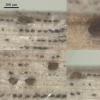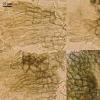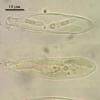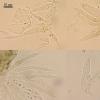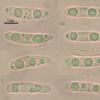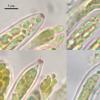
17-12-2025 18:35
 Michel Hairaud
Michel Hairaud
Bonjour à tous/Hi to everyone I am passing along

15-12-2025 15:48
 Danny Newman
Danny Newman
Melanospora cf. lagenaria on old, rotting, fallen

15-12-2025 15:54
 Johan Boonefaes
Johan Boonefaes
Unknown anamorph found on the ground in coastal sa

15-12-2025 21:11
 Hardware Tony
Hardware Tony
Small clavate hairs, negative croziers and IKI bb

15-12-2025 07:09
 Danny Newman
Danny Newman
indet. Rutstroemiaceae sp. on unk. fallen leavesMc

15-12-2025 07:05
 Danny Newman
Danny Newman
Pseudosclerococcum golindoi (det: Zotto)near Cosb

15-12-2025 11:49
 Danny Newman
Danny Newman
ITS sequences from the following two collections B

15-12-2025 12:34
 Danny Newman
Danny Newman
indet. Rhytismataceae on oak leafnear Purchase Roa
Hysteropezizella diminuens
Nina Filippova,
12-02-2013 16:44
From dead leaves of Eriophorum angustifolium, wet bog hollow.
Apothecia immersed in tissue, ellipsoid, to 350 x 170 mk, opening by ellipsoid slit, disc pale, surrounded by dark brown edge.
Excipulum from textura angularis at base, cells dark brown, about 10 mk in diam, textura prismatica at the edge, end cells (hairs) cylindrical or clavate, 15-20 x 5-8, brown, walls of end cells under immersion with roughness; asci clavate, inamyloid, 59-67 x 12,5-14,6; paraphyses cylindrical with ampulliform end cell, about 3 mk broad and segmented in lower part, ampulliform cell up to 5 mk in broadest part, hyaline, with small guttules (rarely seen in rehydrated), not or some exeeding the asci; spores subfusoid, many-guttulate, 17 (15,7-17,7) x 3,7 (3,4-4,2) (Q=4,67; N=13).
Hans-Otto Baral,
12-02-2013 18:09

Re : Hysteropezizella diminuens
Yes, these are globose, rather inconspicuous (low-refractive) VBs which stain turquoise-blue in Cresylblue, but you see them only in living state.
Did you pretread your asci with KOH?
Hysteronaevia olivacea would have inamyloid asci, and paraph. as yours, but has much broader spores with acute ends.
Zotto
Did you pretread your asci with KOH?
Hysteronaevia olivacea would have inamyloid asci, and paraph. as yours, but has much broader spores with acute ends.
Zotto
Nina Filippova,
12-02-2013 19:04
Re : Hysteropezizella diminuens
I used water-lugol, and MLZ and they were inamyloid, now added KOH, heated, and strong amyloid reaction happened. So, this shows they are actually amyloid?
Paraphyses hyaline and brownish in different fbs at one leaf, is seems variable.
I posted Hysteronaevia olivacea some before: http://www.ascofrance.fr/forum?page=1&id=21842
Paraphyses hyaline and brownish in different fbs at one leaf, is seems variable.
I posted Hysteronaevia olivacea some before: http://www.ascofrance.fr/forum?page=1&id=21842
Hans-Otto Baral,
12-02-2013 21:19

Re : Hysteropezizella diminuens
This is the very typical hemiamyloid reaction, and it shows that your Lugol is insufficient. You should get a bright red reaction in water + lugol. Maybe your solution is almost colourless (the photo looks so), or it contains unallowed ingredients. Hemiamyloid rings in Melzer are negative without KOH.
Sorry, I confused your two postings. So yes, this is H. diminuens. My answer on paraphyses, of course, concerned the Hysteronaevia, I will change it accordingly.
Zotto
Sorry, I confused your two postings. So yes, this is H. diminuens. My answer on paraphyses, of course, concerned the Hysteronaevia, I will change it accordingly.
Zotto
Nina Filippova,
13-02-2013 11:55
Hans-Otto Baral,
13-02-2013 12:09

Re : Hysteropezizella diminuens
Yes, this is fine! Possibly the reaction has a blue component that becomes visible at lower iodine concentrations, resulting in a more dirty red (type RB).

